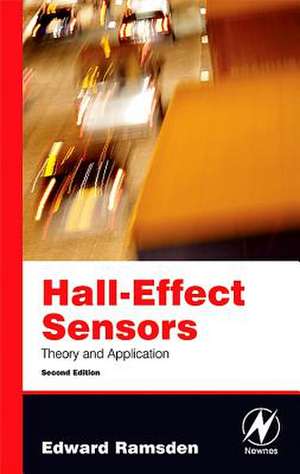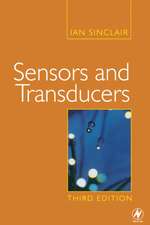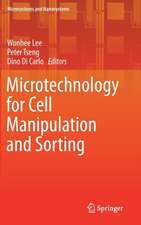Hall-Effect Sensors: Theory and Application
Autor Edward Ramsdenen Limba Engleză Paperback – 28 feb 2006
The importance of these sensors, however, contrasts with the limited information available. Many recent advances in miniaturization, smart sensor configurations, and networkable sensor technology have led to design changes and a need for reliable information. Most of the technical information on Hall effect sensors is supplied by sensor manufacturers and is slanted toward a particular product line. System design and control engineers need an independent, readable source of practical design information and technical details that is not product- or manufacturer-specific and that shows how Hall effect sensors work, how to interface to them, and how to apply them in a variety of uses. This book covers:
the physics behind Hall effect sensors
Hall effect transducers
transducer interfacing
integrated Hall effect sensors and how to interface to them
sensing techniques using Hall effect sensors
application-specific sensor ICs
relevant development and design tools
This second edition is expanded and updated to reflect the latest advances in Hall effect devices and applications
Information about various sensor technologies is scarce, scattered and hard to locate. Most of it is either too theoretical for working engineers, or is manufacturer literature that can t be entirely trusted. Engineers and engineering managers need a comprehensive, up-to-date, and accurate reference to use when scoping out their designs incorporating Hall effect sensors.
* A comprehensive, up-to-date reference to use when crafting all kinds of designs with Hall effect sensors
*Replaces other information about sensors that is too theoretical, too biased toward one particular manufacturer, or too difficult to locate
*Highly respected and influential author in the burgeoning sensors community"
Preț: 411.11 lei
Preț vechi: 461.92 lei
-11% Nou
Puncte Express: 617
Preț estimativ în valută:
78.69€ • 85.50$ • 66.14£
78.69€ • 85.50$ • 66.14£
Carte indisponibilă temporar
Doresc să fiu notificat când acest titlu va fi disponibil:
Se trimite...
Preluare comenzi: 021 569.72.76
Specificații
Cuprins
1.Hall Effect Physics
The theory and math behind the Hall effect.
2.Practical Hall Effect Transducers
Key characteristics, integrated Hall transducers, transducer geometry, examples.
3.Transducer Interfacing
Modeling Hall transducers, biasing, amplifiers, temp. compensation, offset adjustment.
4.Integrated Sensors, Linear and Digital Devices
Linear sensors, switches and latches, speed sensors, application-specific devices.
5.Interfacing to Integrated Hall Sensors
Interface issues, line driver circuits, the pull-up resistor, interfacing to standard logic devices, discrete logic, driving loads, LED interface, incandescent lamps, relays, solenoids, and inductive loads, wiring reduction schemes, encoding and serialization, digital to analog encoding, voltage regulation and power management.
6.Proximity Sensing Techniques
Head-on sensing, slide-by sensing, magnet null-point sensing, float-level sensing, linear position sensing, rotary position sensing, Vane switches,
7.Current Sensing
Resistive current sensing, free-space current sensing, toroidal current sensors, digital current sensor, closed-loop current sensors.
8.Speed and Timing Sensors
Competitive technologies, magnetic targets, vane switches, geartooth sensing, single-point sensing, differential fixed threshold, differential variable-threshold, speed and direction sensing.
9.Application-Specific Hall Sensor ICs
Micro-power switches, two-wire switches, networkable sensors, power devices, smart motor control.
10.Development Tools for Hall Effect Sensors
Electronic bench equipment, magnetic instrumentation, mechanical tools, magnetic simulation software.
Appendix A. Brief Introduction to Magnetics
Appendix B. Suppliers List
Glossary
References and Bibliography
Index
The theory and math behind the Hall effect.
2.Practical Hall Effect Transducers
Key characteristics, integrated Hall transducers, transducer geometry, examples.
3.Transducer Interfacing
Modeling Hall transducers, biasing, amplifiers, temp. compensation, offset adjustment.
4.Integrated Sensors, Linear and Digital Devices
Linear sensors, switches and latches, speed sensors, application-specific devices.
5.Interfacing to Integrated Hall Sensors
Interface issues, line driver circuits, the pull-up resistor, interfacing to standard logic devices, discrete logic, driving loads, LED interface, incandescent lamps, relays, solenoids, and inductive loads, wiring reduction schemes, encoding and serialization, digital to analog encoding, voltage regulation and power management.
6.Proximity Sensing Techniques
Head-on sensing, slide-by sensing, magnet null-point sensing, float-level sensing, linear position sensing, rotary position sensing, Vane switches,
7.Current Sensing
Resistive current sensing, free-space current sensing, toroidal current sensors, digital current sensor, closed-loop current sensors.
8.Speed and Timing Sensors
Competitive technologies, magnetic targets, vane switches, geartooth sensing, single-point sensing, differential fixed threshold, differential variable-threshold, speed and direction sensing.
9.Application-Specific Hall Sensor ICs
Micro-power switches, two-wire switches, networkable sensors, power devices, smart motor control.
10.Development Tools for Hall Effect Sensors
Electronic bench equipment, magnetic instrumentation, mechanical tools, magnetic simulation software.
Appendix A. Brief Introduction to Magnetics
Appendix B. Suppliers List
Glossary
References and Bibliography
Index














